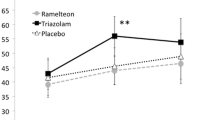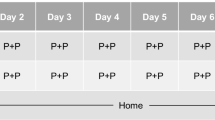Abstract
Rationale
Carbamazepine (CBZ) is known to produce cognitive side effects being at least partly relevant for driving. In contrast to this, the cognitive effects of oxcarbazepine (OXC) are suspected to be less pronounced.
Objective
This study aimed to test 900 mg/day OXC as compared to 600 mg/day CBZ with respect to driving.
Methods
Driving performance of 27 healthy volunteers under subchronic treatment of OXC and CBZ was assessed in a driving simulator with a double-blind, randomized, crossover design including a baseline measurement. The test course contained a representative set of scenarios. Lane-keeping performance, driving mistakes, and eyelid closure (as a behavioral measure of sleepiness) were analyzed. In addition, subjects were asked to assess their driving performance, effort, attention, and sleepiness subjectively.
Results
Both drugs had negative effects on driving as reflected in poorer lane-keeping performance, higher rate of driving mistakes, increased sleepiness, and worse subjective ratings. These effects were most obvious in monotonous situations and could be compensated in situations challenging to cognitive and motor driving skills. With respect to all considered parameters, CBZ did more often differ significantly from baseline than OXC.
Conclusions
Under both drugs, driving performance was worse than at baseline. Even though deterioration of driving performance was only slightly less pronounced under OXC than under CBZ, it might be recommended as more appropriate than CBZ for epileptic patients who need to drive a car.




Similar content being viewed by others
References
Aldenkamp AP, De Krom M, Reijs R (2003) Newer antiepileptic drugs and cognitive issues. Epilepsia 44:21–29
Brenner-Hartmann J, Bukasa B (2002) Durchführung standardisierter Fahrverhaltensbeobachtungen im Rahmen der medizinisch-psychologischen Untersuchung (MPU) BDP-Kongress für Verkehrspsychologie, Regensburg
Curran HV, Java R (1993) Memory and psychomotor effects of oxcarbazepine in healthy human volunteers. Clin Pharm 44:529–533
Dam M, Ekberg R, Loining Y, Waltimo O, Jakobsen K (1989) A double-blind study comparing oxcarbazepine and carbamazepine in patients with newly diagnosed, previously untreated epilepsy. Epilepsy Res 3:70–76
de Gier H (2006) Medicinal drugs. Critical review of present knowledge and statements for discussion transportation research circular. Drugs and traffic. A symposium. Woods Hole, Massachusetts, pp 67–77
Drazkowsky JF (2007) Driving and flying with epilepsy. Curr Neurol Neurosci Rep 7:329–334
Hargutt V (2003) Das Lidschlussverhalten als Indikator für Aufmerksamkeits- und Müdigkeitsprozesse bei Arbeitshandlungen. VDI-Verlag, VDI-Verlag
Hoffmann S, Buld S (2006) Darstellung und Evaluation eines Trainings zum Fahren in der Fahrsimulation. VDI-Gesellschaft Fahrzeug- und Verkehrstechnik. Integrierte Sicherheit und Fahrerassistenzsysteme (VDI-Bericht Nr. 1960). VDI-Verlag, pp 113–132
Martin R, Vogtle L, Gilliam F, Faught E (2005) What are the concerns of older adults living with epilepsy? Epilepsy Behav 7:297–300
Michon JA (1989) Explanatory pitfalls and rule-based driver models. Accid Anal Prev 21:341–353
Ramaekers JG, Lamers CTJ, Verhey F, Muntjewerff ND, Mobbs E, Sanders N, Lewis JM, Lockton JA (2002) A comparative study of the effects of carbamazepine and the NMDA receptor antagonist remacemide on road tracking and car-following performance in actual traffic. Psychopharmacology 159:203–210
Schmidt E, Elger CE (2004) Worin unterscheidet sich Oxcarbazepin von Carbamazepin? Differences between oxcarbazepine and carbamazepine. Der Nervenarzt 75:153–160
Valmain J, Darde JB, Gappmaeier B, Kirker J, Kraemer G, Markschies N, Ojala M, et al. (2005) Epilepsy and driving in Europe. A report of the Second European Working Group on Epilepsy and Driving. European Commision
Wesnes KA, Edgar C, Dean ADP, Wroe SJ (2009) The cognitive and psychomotor effects of remacemide and carbamazepine in newly diagnosed epilepsy. Epilepsy Behav 14:522–528
Acknowledgements
We are grateful to the staff of the Medizinisches Studienzentrum Würzburg who conducted all medical investigations for this study.
Statement of Interest
This study was financially supported by Novartis Pharma GmbH. J Klatt and F Tracik are employees of Novartis Pharma GmbH, Germany.
Author information
Authors and Affiliations
Corresponding author
Rights and permissions
About this article
Cite this article
Kaussner, Y., Kenntner-Mabiala, R., Hoffmann, S. et al. Effects of oxcarbazepine and carbamazepine on driving ability: a double-blind, randomized crossover trial with healthy volunteers. Psychopharmacology 210, 53–63 (2010). https://doi.org/10.1007/s00213-010-1814-y
Received:
Accepted:
Published:
Issue Date:
DOI: https://doi.org/10.1007/s00213-010-1814-y




